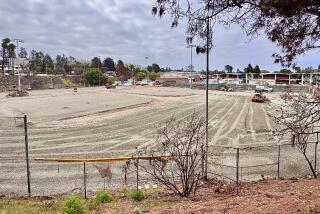The Ambassador’s Second Life
- Share via
Los Angeles Unified School District Supt. Roy Romer has managed to anger both sides in the battle over the historic Ambassador Hotel with his plan to raze much of the property to build a complex of three campuses for 4,200 students, from kindergarten to grade 12.
No one denies the need for a school on the site. But preservationists want to see the hotel renovated and reconfigured to accommodate the campuses, while a coalition of activists, including the Mexican American Legal Defense and Educational Fund and the Cesar E. Chavez Foundation, wants the hotel demolished so schools can be built more quickly and economically.
In a perfect world, the hotel would be saved -- not just as an important piece of the city’s social and architectural legacy but because its historic features have much to contribute to education. But the school district is desperate for space. More than 3,800 students are shut out of nearby overcrowded schools and endure long bus rides daily. The mid-Wilshire area is so densely packed that there are enough children within nine blocks of the site to fill the proposed campuses’ seats right now.
Romer’s plan is not perfect, but it does a fair job of balancing competing interests. It would restore the Cocoanut Grove nightclub to its original Moorish style for use as an auditorium, and convert the coffee shop designed by architect Paul Williams into a teachers lounge. The once-glamorous Embassy Ballroom -- where Robert F. Kennedy spoke moments before he was assassinated in an adjacent pantry -- would come down, but its ornate ceiling and ornamental friezes would decorate the library that would take its place. From Wilshire Boulevard, the site would look like the Ambassador of yore, but its front would be a facade -- a six-story wall shielding school lunch areas and a courtyard that would replace the hotel lobby.
The Los Angeles Conservancy is understandably unhappy about all that would be lost. But the group’s construction proposal is projected to cost between $30 million and $100 million more and take at least six months longer.
The coalition opposing preservation is not mollified either. This week, both sides plan to turn out in force at community and school district hearings, and they will no doubt lobby school board members, who have final say on the plan and are scheduled to vote in October. But in a show of good faith, neither side plans to sue to stall construction. That’s fortunate because the battle over the shuttered Ambassador has already dragged on for 15 years. And even if construction began today, the opening of the new schools is at least four years away.
The battle has been a symbolic one for both sides. A victory for preservationists could energize their movement because the hotel’s legacy as a playground for the city’s rich and famous has drawn the attention of high-profile entertainment types. The neighborhood groups want to make a stand because they’ve been short-changed by Los Angeles Unified too often. But if the school board accepts Romer’s proposal, it would be shortsighted for opponents to see it as a loss. It’s a compromise, one that honors community concerns but requires concessions from both sides. The school board ought to follow the lead of President Jose Huizar, take the heat and back this plan.
More to Read
Sign up for Essential California
The most important California stories and recommendations in your inbox every morning.
You may occasionally receive promotional content from the Los Angeles Times.













